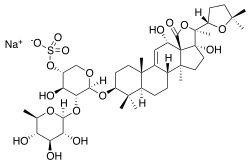
| |
| Names | |
|---|---|
| IUPAC name
Sodium;[(3R,4R,5R,6S)-5-[(2S,3R,4R,5S,6R)-5-[(2S,3R,4S,5R,6R)-4-[(2S,3R,4S,5R,6R)-3,5-dihydroxy-4-methoxy-6-methyloxan-2-yl]oxy-3,5-dihydroxy-6-methyloxan-2-yl]oxy-3,4-dihydroxy-6-methyloxan-2-yl]oxy-6-[[(1S,2S,5R,6S,9S,10S,13S,16S,18R)-6-[(2S)-5,5-dimethyloxolan-2-yl]-5,10-dihydroxy-2,6,13,17,17-pentamethyl-8-oxo-7-oxapentacyclo[10.8.0.02,9.05,9.013,18]icos-11-en-16-yl]oxy]-4-hydroxyoxan-3-yl]] sulfate | |
| Identifiers | |
3D model (JSmol)
|
|
| ChemSpider | |
PubChem CID
|
|
| |
| |
| Properties | |
| C54H85NaO25S | |
| Molar mass | 1189.3 g/mol |
Except where otherwise noted, data are given for materials in their standard state (at 25 °C [77 °F], 100 kPa).
| |

| |
| Names | |
|---|---|
| IUPAC name
Sodium;[(3R,4R,5R,6S)-5-[(2S,3R,4R,5S,6R)-5-[(2S,3R,4S,5R,6R)-4-[(2S,3R,4S,5R,6R)-3,5-dihydroxy-6-(hydroxymethyl)-4-methoxyoxan-2-yl]oxy-3,5-dihydroxy-6-(hydroxymethyl)oxan-2-yl]oxy-3,4-dihydroxy-6-methyloxan-2-yl]oxy-6-[[(1S,2S,5R,6S,9R,10S,13S,16S,18R)-6-(5,5-dimethyloxolan-2-yl)-5,10-dihydroxy-2,6,13,17,17-pentamethyl-8-oxo-7-oxapentacyclo[10.8.0.02,9.05,9.013,18]icos-11-en-16-yl]oxy]-4-hydroxyoxan-3-yl]] sulfate | |
| Identifiers | |
3D model (JSmol)
|
|
| ChemSpider | |
PubChem CID
|
|
| |
| |
| Properties | |
| C54H85NaO27S | |
| Molar mass | 1221.3 g/mol |
Except where otherwise noted, data are given for materials in their standard state (at 25 °C [77 °F], 100 kPa).
| |

| |
| Names | |
|---|---|
| IUPAC name
Sodium;[(3R,4R,5R,6S)-6-[[(5R,6R,10S,13S,16S)-6-[(2S)-5,5-dimethyloxolan-2-yl]-5,10-dihydroxy-2,6,13,17,17-pentamethyl-8-oxo-7-oxapentacyclo[10.8.0.02,9.05,9.013,18]icos-11-en-16-yl]oxy]-4-hydroxy-5-[(2S,3R,4S,5S,6R)-3,4,5-trihydroxy-6-methyloxan-2-yl]oxyoxan-3-yl]] sulfate | |
| Identifiers | |
3D model (JSmol)
|
|
| ChemSpider | |
PubChem CID
|
|
| |
| |
| Properties | |
| C41H63NaO17S | |
| Molar mass | 883 g/mol |
Except where otherwise noted, data are given for materials in their standard state (at 25 °C [77 °F], 100 kPa).
| |
The holothurins are a group of toxins originally isolated from the sea cucumber Actinopyga agassizii.[4] They are contained within clusters of sticky threads called Cuvierian tubules which are expelled from the sea cucumber as a mode of self-defence.[5] The holothurins belong to the class of compounds known as saponins and are anionic surfactants which can cause red blood cells to rupture.[6][7] The holothurins can be toxic to humans if ingested in high amounts.
- ^ "Holothurin". pubchem.ncbi.nlm.nih.gov. National Center for Biotechnology Information.
- ^ "Holothurin A". pubchem.ncbi.nlm.nih.gov. National Center for Biotechnology Information.
- ^ "Holothurin B". pubchem.ncbi.nlm.nih.gov. National Center for Biotechnology Information.
- ^ Chanley, J. D.; Ledeen, R.; Wax, J.; Nigrelli, R. F.; Sobotka, Harry (1959). "Holothurin. I. Isolation, properties, and sugar components of holothurin A". Journal of the American Chemical Society. 81 (19): 5180–5183. doi:10.1021/ja01528a040.
- ^ Ruppert, Edward E.; Fox, Richard, S.; Barnes, Robert D. (2004). Invertebrate Zoology, 7th edition. Cengage Learning. p. 915. ISBN 81-315-0104-3.
{{cite book}}: CS1 maint: multiple names: authors list (link) - ^ Kitagawa, I (1979). "Structure of holothurin A a biologically active triterpene-oligoglycoside from the sea cucumber holothuria leucospilota brandt". Tetrahedron Letters. 20 (16): 1419–1422. doi:10.1016/S0040-4039(01)86166-9.
- ^ "Holothurin". www.ncbi.nlm.nih.gov. National Center for Biotechnology Information.